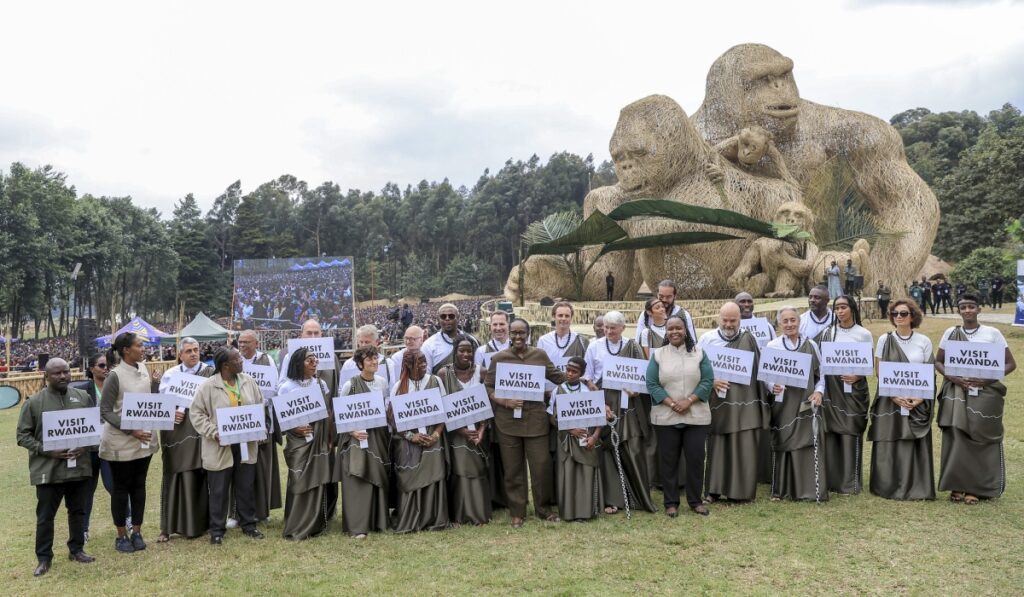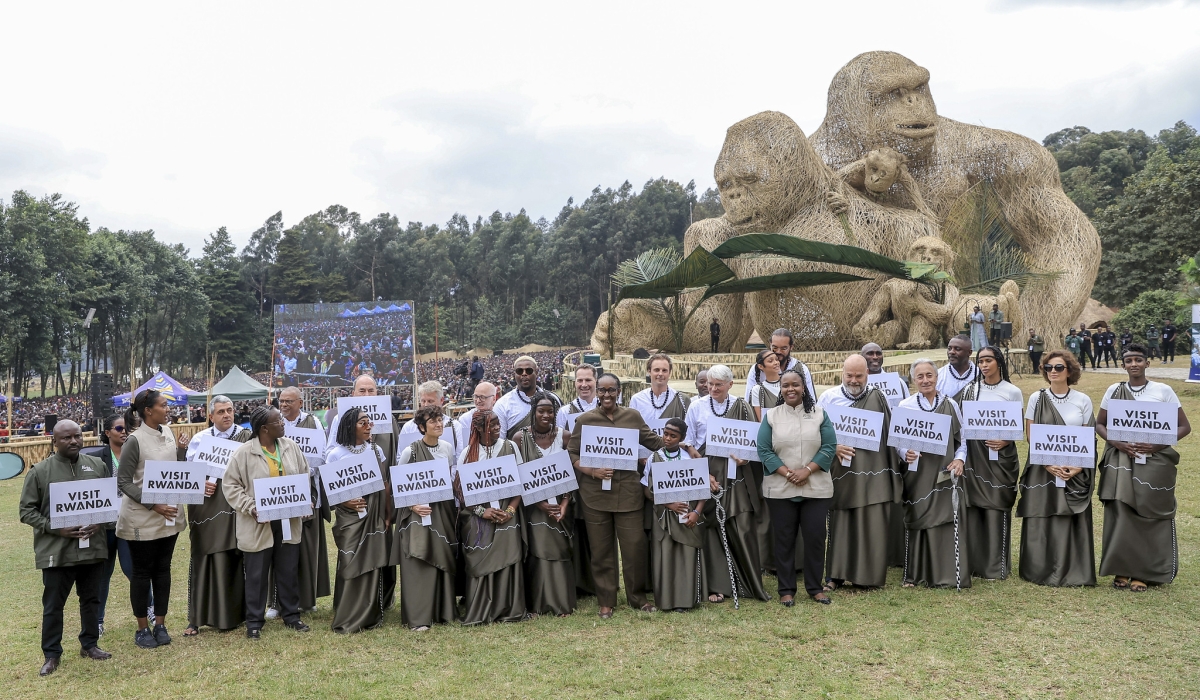There’s so much to unpack about this single event! We saw lots of color, heard some music, and gained insights into the complexities of wildlife conservation, complete with a whirlwind tour of Rwandan history that included references to animal affection, hospitality, and ceremonial naming.
We saw dozens of military and security personnel skating around the grounds.
We looked on with mesmerized gazes as celebrities and dignitaries made a majestic procession in their traditional Rwandan attire into the venue. We watched the enormous cast of the popular Mashirika Performing Arts swirling and spinning with long colorful strings and jingling foot pieces attached to their ankles in a stylized performance.
We listened to the First Lady of Rwanda alongside other government officials make a plea for tolerance and inclusiveness of nature. We became progressively colder as time passed by.
We cheered for the communities around the Volcanoes National Park, as we always do, and marveled at the dedicated efforts they invest in safeguarding the mountain gorillas. And now, if you’re not familiar with the phenomenon of Kwita Izina, let’s clue you in.
“Kwita Izina” is a Kinyarwanda term that translates to “ to give a name,” signifying the act of bestowing a name upon a person or object. The country’s appellative functions are hardly new, according to a Rwandan friend who equipped me with bits and pieces of the ritual. Rwandans (and quite frankly, most Africans) have been hung up on names for centuries.
There’s a Kinyarwanda proverb: “Izina niryo muntu,” which essentially means that a person’s name reflects their character and identity. In the specific context we are discussing, “Kwita Izina” harks back to an age-old Rwandan tradition where the community would come together to give a name to a newly born baby within their midst. In the current context, however, this tradition extends to baby gorillas instead of human infants.
“On Kwita Izina day, it was customary for people to gather in front of their television screens to witness the live ceremony,’” said Ange, my friend. “’Children, in particular, would often go as far as engaging in friendly wagers, speculating whether the baby gorillas would receive names matching their own. I’m sure they still do that now — it’s a big deal.”
You see, the Kwita Izina festival demonstrates that wildlife conservation has characterized Rwanda since its earliest post-genocide years. The government recognized the immense value of these gorillas 19 years ago, and, as a result, initiated substantial investments in ecotourism and environmental preservation through the Office of Tourism and National Park (ORTPN).
Almost two decades later, the gorilla population has achieved a remarkable and notable resurgence, with numbers increasing from 680 in 2008 to approximately 1,000. This recovery prompted the International Union for Conservation of Nature (IUCN) to reclassify their status, shifting them from “Critically Endangered” to “Endangered” in November 2018.
In the picturesque village of Kinigi, nestled in the foothills of the Virunga Mountains, the vibrant spirit of the Kwita Izina community came to life on Friday, September 1. What began with a lively crowd of a few thousand quickly swelled into tens of thousands.
The Kwita Izina poster-lined streets buzzed with excitement as people made their way to an outdoor area where they could witness the naming ceremony of the 23 baby gorillas born in the past year, both in person and on expansive screens strategically placed throughout the venue.
Families arrived with their little ones in tow, and parents hoisted their children onto their shoulders, all in high spirits, eager for the festivities, seemingly unfazed by any concerns about the weather. Any grumbles about the preparations for the influx of visitors appeared to have been cast aside as the city geared up for its momentous day in the open air.
This year’s Kwita Izina ceremony adopted the motto “Conservation is Life.” As is customary in Rwanda, discipline during the event was willingly and promptly observed by many attendees; blockades were placed throughout the afternoon to maintain some order in the crowd, yet it appeared that nobody seemed to mind.
A clutch of young people wearing green T-shirts and baseball caps, waving small scraps of Rwandan flags stood behind these barriers, eagerly singing and dancing while awaiting the festivities to begin.

The communities residing near the Virunga National Park undoubtedly grasp the profound significance of Kwita Izina. There’s a kind of mutual exchange between humans and gorillas, and to call it impressive would be an understatement.
“Since the annual ceremony began, 374 baby mountain gorillas have been named, and the population in the Virunga massif has grown by 23% over the last decades,”’ said Michaella Rugwizangoga, the Chief Tourism Officer for the Rwanda Development Board (RDB), who attributes this remarkable achievement to the communities living around the park, dedicated conservationist researchers, as well as visionary leadership.
The local communities serve as the gorillas’ closest neighbors and play a vital role in gorilla conservation. Their active participation in Kwita Izina, a tradition deeply ingrained in their understanding, has transformed them into crucial allies in the conservation endeavor.
‘Through our unique tourism revenue sharing program, Rwanda reinvests 10% of park tourism received into the communities surrounding the park,” said Rugwizangoga.
”To date, close to $10 million has been invested in more than a thousand projects in communities leading adjacent to the Volcano National Park, Akagera National Park, Gishwati Mukura, and Nyungwe National Park,” she went on, ”We have built schools and homes for vulnerable families, water supply system, as well as modern markets and community health centers. Just last week, we integrated two new projects, a maternity yard and a potato seed center that will develop as a result of direct consultation with the communities in Nyaruguru district in the Southern province.”
Furthermore, gorilla tourism has generated employment opportunities for many local residents who serve as park guides, tour guides, hotel staff, and suppliers of food to hotels, among other roles. So, when you embark on a gorilla tour in Rwanda, you are actively contributing to both the socio-economic development of the local communities and the conservation efforts aimed at protecting the mountain gorillas of Rwanda.
But the Kwita Izina ceremony has evolved to embrace a broader audience beyond just Rwandans. It has become a magnet for celebrities and dignitaries, both international and local.
Diverse prominent figures are extended invitations to name the baby gorillas. They can choose names from a list of suggested local names or propose their own, which is then translated into the local dialect. This inclusion of prominent participants has brought considerable prestige and attention to the Kwita Izina ceremony.
The choices of names submitted were imbued with sentimental themes. This year, Kevin Hart commenced the naming session of Kwita Izina by virtually christening his baby gorilla “Gakondo.” The renowned comedian and actor had visited the gorillas in Rwanda a few weeks prior.
Among the other participants were Sabrina Elba, a Canadian model and goodwill ambassador for the United Nations, and wife to the esteemed British actor Idris Elba, who chose the name “Narame” to symbolize long life.
UK Minister Andrew Mitchell named his baby gorilla “Mukundwa,” while Zurab Pololikashvili, the Secretary General of the United Nations World Tourism Organization (UNWTO), named the gorilla “Inshingano.”
Additionally, famous names such as Nigeria’s Asa, former Chicago Bulls center forward Joakim Noah, and Sol Campbell, the legendary Arsenal and England player, alongside Larry Green, a Board Trustee at the African Wildlife Foundation (AWF), were among the 23 namers who participated in this year’s event.
My favorite naming moment so far might have been a pretty biased one: Danai Gurira, the Zimbabwean-American actress renowned for her role in Black Panther, paid a touching tribute to Chadwick Boseman who was a fervent admirer of the African continent before his passing.
She named her baby gorilla “Aguka T’Challa,” a nod to Boseman’s portrayal of the King of Wakanda in Black Panther. In Kinyarwanda, “Aguka” signifies expansion.
As the festival approached its conclusion, Clare Akamanzi, the Chief Executive Officer at RDB, encouraged more investments: “Nature-based tourism has been the cornerstone of our recovery since the COVID 19 pandemic. I’m happy to share that we are set to exceed our pre pandemic tourism revenues this year, 2023.
Our tourism revenues for the first half of 2023 increased by 56% compared to the same period last year. Our investment climate is ranked second in Africa. Our country is safe and our economy is fast-growing.”
The First Lady of Rwanda, Jeanette Kagame, followed with a sharp but nuanced speech in which she emphasizes that Kwita Izina is more about gratitude, not a favor to nature. Conservation, she said, has granted us survival, shelter, nourishment, and wonder from our very first days as a species.
“It seems almost unbelievable that while this earth is humanity’s most precious gift, its sources and origin of life, we have found the recklessness to abuse it over and over again.” Continuing a speech of admirable caution, she said, “Let us not mistake our earth’s kindness for weakness. Let us not interpret its hospitality as dependency upon us. The sooner we act, the sooner we can reverse our current trend towards an eventual absolute ecosystem collapse.”
One aspect that often goes unnoticed by those watching on TV or reading newspapers is the unheralded hero of Kwita Izina: the cameramen and reporters stationed at every corner of the venue.
At one point during the ceremony, rain began to pour, adding an extra layer of challenge to their high-stakes job: capturing video footage seen by hundreds of thousands while balancing the risk of not toppling over or having their recording equipment soaked.
Some were well-prepared, swiftly donning their raincoats and opening umbrellas. Your correspondent (me), on the other hand, was not as foresighted and had to share a cramped umbrella with one of the videographers, all the while struggling to document every detail as the rain continued to patter down.

